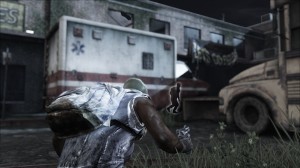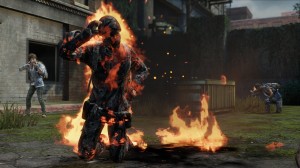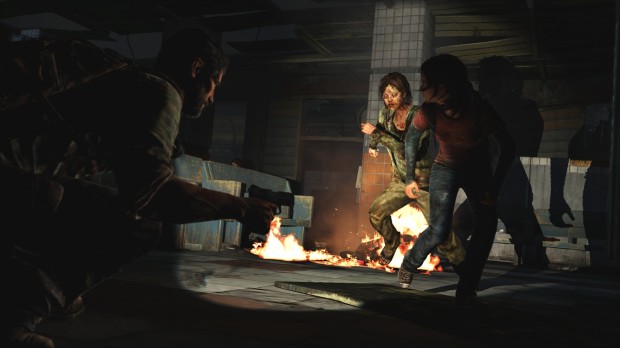The Last Of Us Review
This game was reviewed on the PlayStation 3.
***EDITOR’S NOTE*** – Multiplayer was not available for review at the time that we were looking at the game.
Naughty Dog tries their hand at survival horror in their latest third-person action-adventure game, The Last of Us. You take up the role of Joel, a survivor of a world set 20 years after a virus turns the majority of the general population into not zombies, but rather a bunch of carnivorous mushrooms. You are tasked with the mission of delivering a young girl by the name of Ellie into the hands of the Fireflies (a group dedicated to opposing the rule of the military government left in place after all hell broke loose), for she apparently has an immunity to the mind-controlling cordyceps-style fungus that turns humans into spore-spewing zombies. Dealing with the ghosts of his past, including the loss of his own daughter during the outbreak, Joel reluctantly takes the job to venture out beyond the quarantine zone, into the overgrown world of what was, to make the delivery.
The Last of Us is a third-person style action-adventure game with survival horror elements. As a third-person action game, it’s really easy to start drawing a lot of parallels to Naughty Dog’s previous smash hit series Uncharted, but don’t let yourself get fooled into thinking that this is another Nate Drake adventure with a zombie façade painted on the front. You’ll find that the unruly canines from Santa Monica packed in a good amount of new features in The Last of Us to make it stand on its own. The most immediately noticeable differences come from the gameplay itself. There is no jump, so making those impossible leaps of faith across chasms may be out, but exploration and environmental puzzles are still abound. The melee system is also drastically different. Depending on what items and equipment you’re carrying, you can strangle or shiv your unsuspecting adversary, bonk them with a lead pipe, or hold them up as a meat shield to protect you while you gun down their buddies. Stealth is also integral to gameplay, as you’ll find yourself quickly overwhelmed if you alert your enemies to your presence. This is due in part to the fact that your resources are more limited than most shooters. Long gone is the ability to carry around 75 magazines of ammunition with you. Instead, you might be lucky to have three or four. Fabricated weapons such as shivs and melee weapons like baseball bats and lead pipes also have a limited life span, forcing you to conserve what you have and opt for sneaking around instead of facing an onslaught of enemies outright.
 A new feature unique to The Last of Us is the listening system. Using the right trigger, Joel has the ability to concentrate and listen closely to determine his enemies’ positions and what direction they’re headed in. While this mode is enabled, Joel also steps more softly, making him harder to hear in turn. It is so effective, however, that it becomes very easy to rely upon, which inevitably diminishes the challenge of the game.
A new feature unique to The Last of Us is the listening system. Using the right trigger, Joel has the ability to concentrate and listen closely to determine his enemies’ positions and what direction they’re headed in. While this mode is enabled, Joel also steps more softly, making him harder to hear in turn. It is so effective, however, that it becomes very easy to rely upon, which inevitably diminishes the challenge of the game.
An additional tool in your arsenal alongside the ninja-like stealth that Joel possesses is the art of distraction. Bricks and bottles can be picked up and tossed across a room to get your enemies’ attention, but at a cost, as it typically works them up into a frenzy, sending them out in every direction looking for the culprit that made the noise. In settings of one or two enemies it works just fine, but if there are more, you can quickly find yourself fighting for your life against overwhelming numbers. If you’re facing just one enemy, however, you can toss a brick or bottle at his noggin to stun him long enough to hit him with that rusty metal pipe with the scissors duct taped to the end. The results are often hilarious, if you can find humour in the macabre.
 One aspect of the game that I particularly enjoy is the item creation and upgrade system in the game. The upgrade system is three-fold, where items can be assembled to create makeshift weapons, bombs, smoke grenades, or med-kits. Pills can be used to upgrade Joel’s skills including his health bar, listening distance, and how quickly he can craft items. Spare parts can be used for upgrading your weapons such as guns, pistols, and bows, but also require a tool level for certain upgrades. These tools are hidden throughout the game, which gives you one more reason to search every nook and cranny. Along with items for crafting and upgrades, documents are littered throughout to give you additional backstory to the game, give you tips, or even additional recipes for making more powerful items.
One aspect of the game that I particularly enjoy is the item creation and upgrade system in the game. The upgrade system is three-fold, where items can be assembled to create makeshift weapons, bombs, smoke grenades, or med-kits. Pills can be used to upgrade Joel’s skills including his health bar, listening distance, and how quickly he can craft items. Spare parts can be used for upgrading your weapons such as guns, pistols, and bows, but also require a tool level for certain upgrades. These tools are hidden throughout the game, which gives you one more reason to search every nook and cranny. Along with items for crafting and upgrades, documents are littered throughout to give you additional backstory to the game, give you tips, or even additional recipes for making more powerful items.
While sneaking around and trying to be unseen works most of the time, the inevitable fact is that you will on occasion (maybe more frequently for me) find yourself making a noise, getting caught in the corner of someone’s eye, or raising a general alarm, and everything goes to crap. It’s during these times when a good, accurate trigger hand and cool wits are needed to prevail as a couple of hits from a shotgun, or just being poorly equipped against a particular infected form, will easily take you down for the count. Combat situations can easily throw you off your equilibrium with its frenetic pacing, managing limited ammo, and the need to keep moving in order to avoid being cornered. But what really gets you wound up full of paranoia are the pop scares coming in the form of noiseless (and therefore unseen) enemies around the corner, or exploding traps when you’re not looking (which got me so bad once that I almost literally threw the controller at poor Jack as I jumped in surprise).
There are nonetheless some missed opportunities to further tug at the paranoia strings of the gamer, such as with the spores. In certain subterranean levels in the game, clouds of spores exist, and our hero must don his gas mask to avoid becoming infected. Aside from your champion walking around in some stylish 1920’s bio-garb, there’s no point to these spore clouds. There’s no way to lure your enemies unknowingly into them to cause them an agonizing death, nor do you have to remember your mask, because the game does it for you.
When you’re not doing your best to avoid becoming the next addition to the infected family, piling the gates high with hunter bodies, or avoiding the army, you might stop for a minute to take in the sights. Naughty Dog continues the tradition of squeezing blood from the graphical stone to create some of the best visuals that you’ll find on the PlayStation 3. Their ability to create beauty in an overgrown post-apocalyptic world never ceases to amaze, from the broken down and flooded innards of buildings that once flourished with business people, tourists, or the average Joe, to the lush, almost tropical overgrowth that’s worked so hard to reclaim the cityscapes that have been long abandoned of hope and fortune. Along with the beautiful environmental visuals come the stunningly detailed and meticulously motion-captured character models that are the best yet seen on the PlayStation 3, and will likely be seen on the aging console.
 But what really steals the show once again is Naughty Dog’s ability to craft a truly engaging story, where the relationships between the characters are just as important as the mechanics of the game. Every cutscene finds its way to tug on the emotional heartstrings of the player, while every moment in-game is an opportunity for casual conversation and witty one-liners that the developer is known for. Once again, the Santa Monica studio has found a cast of voice actors that has a solid chemistry between each other to add to the drama and emotion that they’re looking to convey. Troy Baker’s role as the grizzled and heartbroken Joel is a more serious role than we’ve seen him portray in recent years, while Ashley Johnson’s performance as the strong, but at times childish, Ellie solidifies the father-daughter bond that’s created throughout their characters’ trials.
But what really steals the show once again is Naughty Dog’s ability to craft a truly engaging story, where the relationships between the characters are just as important as the mechanics of the game. Every cutscene finds its way to tug on the emotional heartstrings of the player, while every moment in-game is an opportunity for casual conversation and witty one-liners that the developer is known for. Once again, the Santa Monica studio has found a cast of voice actors that has a solid chemistry between each other to add to the drama and emotion that they’re looking to convey. Troy Baker’s role as the grizzled and heartbroken Joel is a more serious role than we’ve seen him portray in recent years, while Ashley Johnson’s performance as the strong, but at times childish, Ellie solidifies the father-daughter bond that’s created throughout their characters’ trials.
The Last of Us may not be the last great title for the PlayStation 3, but it most certainly deserves its place as one of the greatest titles created for the console. Naughty Dog has managed to put a fresh spin on a genre that’s been long overused, and shows us once again that they’re capable of exceeding our expectations with every release while setting the bar impossibly high for others to reach.
About This Post
